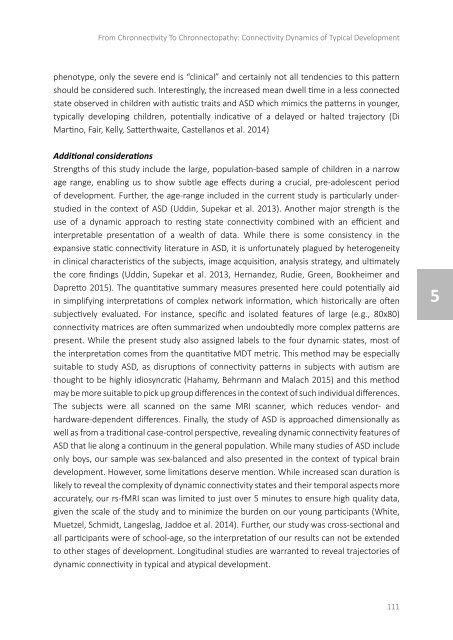On the Spectrum
2lm5UyR
2lm5UyR
You also want an ePaper? Increase the reach of your titles
YUMPU automatically turns print PDFs into web optimized ePapers that Google loves.
From Chronnectivity To Chronnectopathy: Connectivity Dynamics of Typical Development<br />
phenotype, only <strong>the</strong> severe end is “clinical” and certainly not all tendencies to this pattern<br />
should be considered such. Interestingly, <strong>the</strong> increased mean dwell time in a less connected<br />
state observed in children with autistic traits and ASD which mimics <strong>the</strong> patterns in younger,<br />
typically developing children, potentially indicative of a delayed or halted trajectory (Di<br />
Martino, Fair, Kelly, Satterthwaite, Castellanos et al. 2014)<br />
Additional considerations<br />
Strengths of this study include <strong>the</strong> large, population-based sample of children in a narrow<br />
age range, enabling us to show subtle age effects during a crucial, pre-adolescent period<br />
of development. Fur<strong>the</strong>r, <strong>the</strong> age-range included in <strong>the</strong> current study is particularly understudied<br />
in <strong>the</strong> context of ASD (Uddin, Supekar et al. 2013). Ano<strong>the</strong>r major strength is <strong>the</strong><br />
use of a dynamic approach to resting state connectivity combined with an efficient and<br />
interpretable presentation of a wealth of data. While <strong>the</strong>re is some consistency in <strong>the</strong><br />
expansive static connectivity literature in ASD, it is unfortunately plagued by heterogeneity<br />
in clinical characteristics of <strong>the</strong> subjects, image acquisition, analysis strategy, and ultimately<br />
<strong>the</strong> core findings (Uddin, Supekar et al. 2013, Hernandez, Rudie, Green, Bookheimer and<br />
Dapretto 2015). The quantitative summary measures presented here could potentially aid<br />
in simplifying interpretations of complex network information, which historically are often<br />
subjectively evaluated. For instance, specific and isolated features of large (e.g., 80x80)<br />
connectivity matrices are often summarized when undoubtedly more complex patterns are<br />
present. While <strong>the</strong> present study also assigned labels to <strong>the</strong> four dynamic states, most of<br />
<strong>the</strong> interpretation comes from <strong>the</strong> quantitative MDT metric. This method may be especially<br />
suitable to study ASD, as disruptions of connectivity patterns in subjects with autism are<br />
thought to be highly idiosyncratic (Hahamy, Behrmann and Malach 2015) and this method<br />
may be more suitable to pick up group differences in <strong>the</strong> context of such individual differences.<br />
The subjects were all scanned on <strong>the</strong> same MRI scanner, which reduces vendor- and<br />
hardware-dependent differences. Finally, <strong>the</strong> study of ASD is approached dimensionally as<br />
well as from a traditional case-control perspective, revealing dynamic connectivity features of<br />
ASD that lie along a continuum in <strong>the</strong> general population. While many studies of ASD include<br />
only boys, our sample was sex-balanced and also presented in <strong>the</strong> context of typical brain<br />
development. However, some limitations deserve mention. While increased scan duration is<br />
likely to reveal <strong>the</strong> complexity of dynamic connectivity states and <strong>the</strong>ir temporal aspects more<br />
accurately, our rs-fMRI scan was limited to just over 5 minutes to ensure high quality data,<br />
given <strong>the</strong> scale of <strong>the</strong> study and to minimize <strong>the</strong> burden on our young participants (White,<br />
Muetzel, Schmidt, Langeslag, Jaddoe et al. 2014). Fur<strong>the</strong>r, our study was cross-sectional and<br />
all participants were of school-age, so <strong>the</strong> interpretation of our results can not be extended<br />
to o<strong>the</strong>r stages of development. Longitudinal studies are warranted to reveal trajectories of<br />
dynamic connectivity in typical and atypical development.<br />
5<br />
111


